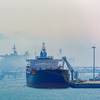Floating Windmills in Japan Help Wind Down Nuclear Power
Japan is preparing to bolt turbines onto barges and build the world’s largest commercial power plant using floating windmills, tackling the engineering challenges of an unproven technology to cut its reliance on atomic energy.
Marubeni Corp., Mitsubishi Heavy Industries Ltd. and Nippon Steel Corp. are among developers erecting a 16-megawatt pilot plant off the coast of Fukushima, site of the nuclear accident which pushed the government to pursue cleaner energy. The project may be expanded to 1,000 megawatts, the trade ministry said, larger than any wind farm fixed to the seabed or on land.
“Japan is surrounded by deep oceans, and this poses challenges to offshore wind turbines attached to the bottom of the sea,” Senior Vice Environment Minister Katsuhiko Yokomitsu said at a meeting in Tokyo this month. “We are eager for floating offshore wind to become a viable technology.”
The world’s third-largest economy is struggling to diversify its energy mix after last year’s earthquake and tsunami crippled Tokyo Electric Power Co.’s Fukushima Dai-Ichi nuclear station. A few countries, including Britain, the U.S. and South Korea, are testing windmills which float, a technology far more expensive than most fossil-fuel or renewable energies.
Mitsubishi Heavy Industries and its partners are positioning themselves for future contracts to develop gear that so far isn’t used in commercial electricity production.
Capital expenditure is about $1.7 million a megawatt for an onshore wind project and $5.5 million a megawatt for offshore, according to Bloomberg New Energy Finance. Statoil ASA has the largest floating project currently, a 2.3-megawatt “Hywind” turbine off the coast of Norway, which cost $29 million a megawatt, according estimates by Fraser Johnston, an offshore wind analyst for the agency in London, based on company data.
“Hywind is a 10-year project, from the drawing board in 2001 to when we were done with the demo period last year,” Morten Eek, a Statoil spokesman, said by phone. “In a commercial phase, the costs will be significantly lower, based on the experience from the demo project.”
Statoil is currently considering two test parks off Scotland and the U.S. with 3-5 windmills each, potentially by 2016.
In Japan, the country “certainly has excellent offshore wind resources and huge potential to develop this sector,” Justin Wu, lead wind analyst for New Energy Finance in Hong Kong, said in an e-mail. “But offshore wind is significantly more expensive than onshore wind at the moment.”
Japan, whose island geography and earthquake risk have long shaped its economy, is lagging behind developed nations, including the U.S., Germany and Spain, in wind energy, which supplied just 0.4 percent of its electricity demand in 2010, according to the International Energy Agency Wind 2010 Annual Report. Ranking as the world’s fifth-largest carbon emitter, Japan is trying to elevate its wind-energy capacity from 2,500 megawatts, the 13th-highest among all nations, according to the Global Wind Energy Council.
Land-based wind-energy development is limited by Japan’s mountains, making offshore developments more viable. The depths of its oceans creates a larger potential for floating turbine technology, still in its infancy compared with the more conventional method of deploying fixed versions of the machines.
The turbines are mounted on a floating structure, which allows them to generate electricity in water depths where bottom-mounted towers cannot be erected easily. The country aims to develop the floating offshore wind turbines for commercialization by March, 2017.
The toughest challenge in erecting floating turbines offshore is ensuring that the buoyancy mechanisms are stable, and getting fixed lines to the sea floor, which can be extended to depths of 200 meters (656 feet).
A so-called feed-in tariff program, due to start in July, which guarantees above-market rates for clean energy, including solar, wind and geothermal, could boost the development of wind energy, analysts say.
“We believe that Japan’s sluggish wind market will experience a kick-start under the FIT,” CLSA Asia-Pacific Markets analysts Penn Bowers and Dean Enjo said in a February 20 report. “Historically, in countries which have implemented FIT schemes it is wind, not solar, that grows the most,” it said, citing Germany and China as examples.
Japan’s production of wind turbines and parts and maintenance services is forecast to grow from an estimated 300 billion yen ($3.6 billion) a year currently to 500 billion yen in 2030, according to the Japan Wind Power Association.
The industry group has set a wind-power installation target of 50,000 megawatts by March, 2051, including 17,500 megawatts and 7,500 megawatts in floating and fixed offshore wind, respectively. That compares with the 49,000 megawatts of nuclear power, which is being debated by government officials after the Fukushima meltdowns. JWPA estimates Japan’s potential for wind is 144,000 megawatts for onshore and 608,000 for offshore.
The Japanese government hasn’t determined what rates they will earn. A delay in price setting may deter investments and put wind power at a disadvantage, compared with solar, because it takes longer to build a wind farm.
A new regulation, due to take effect in October, could also delay wind projects. Wind will be added to a list of power plants, such as nuclear and thermal, which will be subjected to environmental impact assessments to address concerns on noise and birds.
Such surveys can take as many as four years and cost developers an additional 100 million yen for a plant with about 10 turbines, according to Tetsuro Nagata, president of the wind association.
That also means that wind developers may fail to take advantage of the first three years when feed-in tariffs are expected to be higher, he said in an interview.
“Even though the government may set high tariff prices, developers will be left unable to do anything,” while conducting an assessment, Nagata said. “That is not fair.”
The government is considering measures to simplify the process, said Kenji Kamita, an official at the Ministry of Environment who oversees assessment of projects.
To increase wind capacity in a mountainous country, Japan is looking offshore, where wind speeds are faster and more stable.
“Japan has a weak position in onshore wind,” the trade ministry’s task force on new energy industries said in a report released March 12. “But the floating offshore technology is not yet established, so this is an area we can aim for a comeback.”
The environment ministry plans to set up a 2-megawatt floating offshore turbine in Nagasaki in southwestern Japan by June, 2013. The project is being developed by Toda Corp. and Fuji Heavy Industries Ltd.
The Fukushima pilot project will have three floating turbines installed by March, 2016, with plans to eventually expand the capacity to 1,000 megawatts in the region, according to the trade ministry. It has set aside 12.5 billion yen as the ceiling to fund the initial stages of the study.
The trade ministry has also been steadily increasing funding for offshore wind research and development, mainly for fixed turbines, from 200 million yen in 2008 to 5.2 billion yen this year.
For offshore wind farms, cooperation with local fishing industries is also a key, said Chuichi Arakawa, a professor at the University of Tokyo, who studies wind power.
“It all begins with having thorough discussions with local partners,” he said. (Bloomberg)












